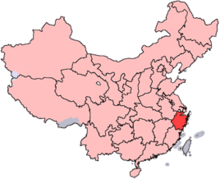| Anji Bai Cha | |
|---|---|
| Type | Green |
| Other names | Anji white tea,安吉白茶 |
| Origin | Anji County, Zhejiang Province, China |
| Quick description | Rare, large-leafed green tea |
 |
Anji bai (Chinese: 安吉白; pinyin: Ānjí bái; pronounced [án.tɕǐ pǎɪ]) or Anji white[1] is a green tea originally produced in Anji County, Zhejiang Province, China.[1] Now, it can also be found in Changxing County, Zhejiang Province, China.
This tea cultivar was discovered in 1982, is not as widely planted as other teas and has a short harvesting period; it is a comparatively rare tea, and as such, is among the most expensive teas in China.[2]
It is called "white" tea although it is a green tea.[3] The long, narrow leaves are yellow in colour and have a recognisable fold along the length of the leaf.[4]
A 2010 study found that the tea is high in polysaccharides which can inhibit the hemolysis of blood cells.[5]
See also[edit]
References[edit]
- ^ a b "An Ji Bai Cha". Archived from the original on 2016-03-10. Retrieved 2016-02-24.
- ^ "Anji White Tea". Kaleidoscope - Food Culture. Cultural China. Archived from the original on 6 June 2014. Retrieved 4 June 2014.
- ^ "Anji White Tea". Tea Encyclopedia. Archived from the original on 8 September 2014. Retrieved 4 June 2014.
- ^ Mary Lou Heiss; Robert J. Heiss (18 January 2012). The Tea Enthusiast's Handbook: A Guide to the World's Best Teas. Ten Speed Press. p. 44. ISBN 978-1-60774-378-1.
- ^ Victor R. Preedy (2013). Tea in Health and Disease Prevention. Academic Press. p. 233. ISBN 978-0-12-384937-3.
Well, that’s interesting to know that Psilotum nudum are known as whisk ferns. Psilotum nudum is the commoner species of the two. While the P. flaccidum is a rare species and is found in the tropical islands. Both the species are usually epiphytic in habit and grow upon tree ferns. These species may also be terrestrial and grow in humus or in the crevices of the rocks.
View the detailed Guide of Psilotum nudum: Detailed Study Of Psilotum Nudum (Whisk Fern), Classification, Anatomy, Reproduction